On the northwest coast of Peru, a stone’s throw from pretty, colonial Trujillo, lies the sleepy but stunning beach town of Huanchaco – a destination that you definitely want to add to your Peru travel itinerary.
Sandwiched between the arid desert and the breaking waves, it’s a friendly little town filled with delicious food and a laid-back surf mentality.
With access to the ruined cities and temples of the ancient Chimu and Moche people nearby, gorgeous sunsets into the sea and beach, and the freshest ceviche everyday, Huanchaco is one of Peru’s destinations that you have to visit, and is the perfect point on a journey through Peru to stop, kickback and relax a little.
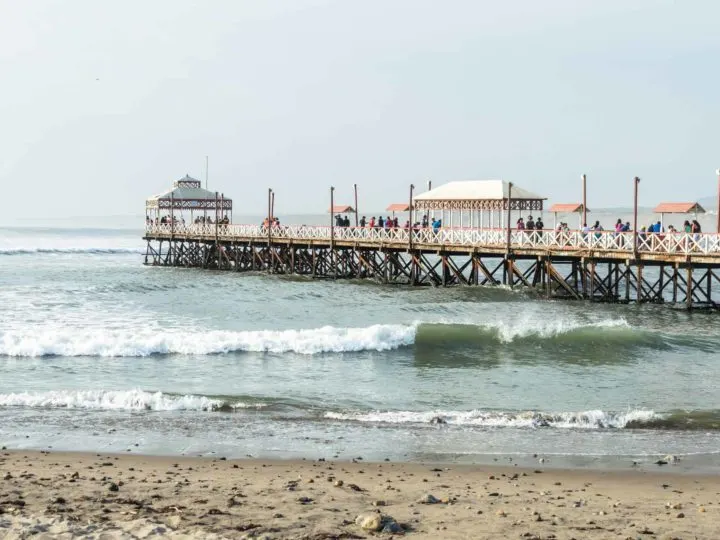
Things to do in Huanchaco
Go crazy about surfing
With cold water and a rocky seabed, Huanchaco is not the best surfing on the west coast. Despite this, Huanchaco is crazy about surfing. Everyday you will find surfers on the main swell down the right side of the pier, as well as scattered down the coast.
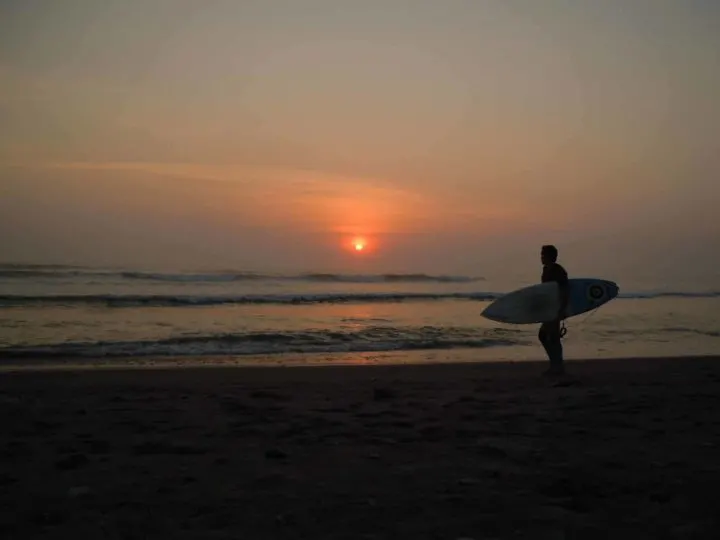
There are a lot of places along the Huanchaco beach offering well-priced surf lessons every morning and afternoon, and there are as many board rental places as bars. Rentals can be hourly or daily and many hostels give deals to their guests.
If surfing is really your thing, you can take a day trip to Chicama and ride the world’s longest waves. This is open to beginners as well and could be a great way to really get into surfing.
Planning Your Trip to Peru?
Save time, stress & money with a customized travel itinerary planned for you by a Peru expert
There are many surf schools and hostels that offer transportation services. If you want to make your own way there, you can take a bus to Puerto Malabrigo.
Make your way 20 minutes south of Huanchaco to Trujillo’s Santa Cruz terminal where a bus leaves every two hours for the surf spot.
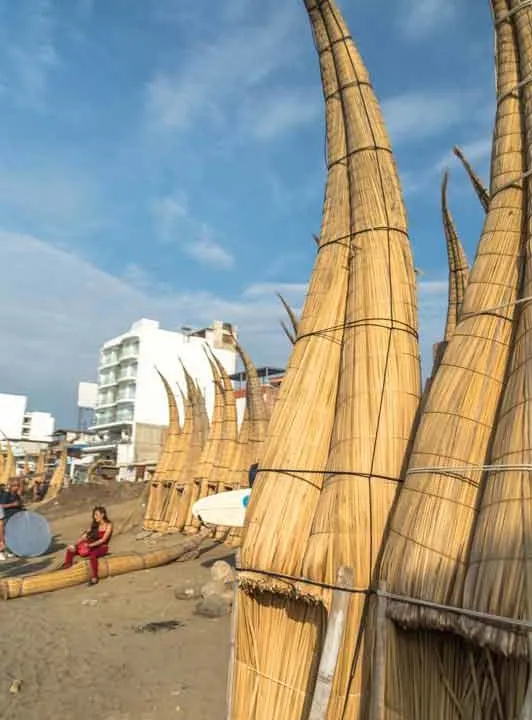
The locals also do a different sort of surfing on their famous caballitos de totora fishing vessels. The name translates to “little reed horses” and refers to the way they are straddled like a horse when used.
There is evidence of these crafts being used in Peru for 3000 years and still today the local fisherman paddle out on them to fish close to the shore. For a small fee, you can even hop on board one of these vessels for a short trip around the harbour.
So even if surfing isn’t your thing, this is one of the best beaches in Peru to enjoy a cocktail while watching the learners fall in waves, the pros cut along the long waves, and the fisherman paddle strongly out on their reed horses.
Dine on the freshest ceviche
Seafood is always best when it’s fresh, and it doesn’t get much fresher than Huanchaco. While there is a wide array of seafood on offer, ceviche is the real gem.
This famous Peruvian dish is raw seafood mixed with lime juice and seasoned with salt, coriander and chilli. This is definitely a case of less is more and this dish is perfect for lightening up hot, heavy afternoons with a cold beer.
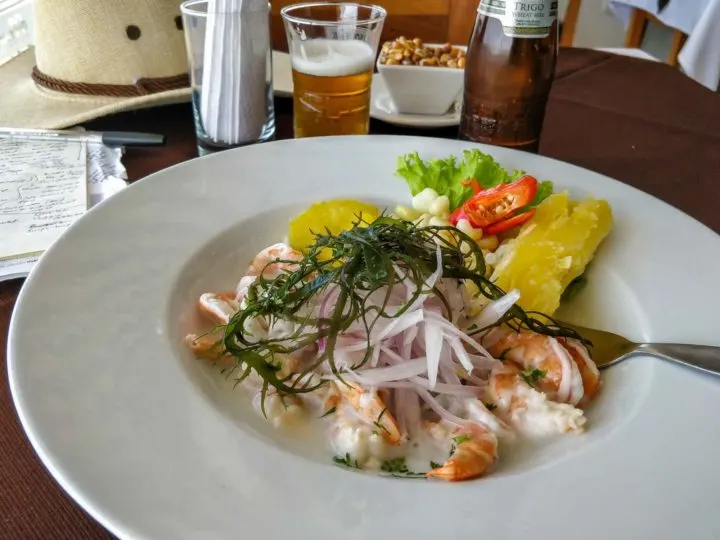
There are endless seafood restaurants in Huanchaco that are often changing. There is options at every budget and it is often overwhelming to decide where to eat!
For some of the most reliable seafood, Restaurant Big Ben, is an excellent, if somewhat pricey, choice.
If you’re on more of a budget, it’s best to ask a local as cheaper fish destinations can go in and out of fashion. Ask at your accommodation or surf school for the places the locals love – and that won’t make you ill!
Attractions outside of Huanchaco
While Huanchaco is a great place to work on your tan, there is a lot more to do in the surrounding areas. With frequent local buses, you can easily explore the surrounding areas which boast many attractions.
Chan Chan
Everyone’s heard of the Incas and their wondrous stone cities, but have you heard of the Chimu people and their adobe capital Chan Chan, once the largest city in the Americas?
Sitting just 10 kilometres south of Huanchaco, this ruined fortress city should be at the top of your to do list. Chan Chan, was invaded and abandoned by the Incas in the 15th century, and then left to erode away.
It was only in 1986 that this ruined city of Peru was recognised by UNESCO as a world heritage site and who then began working to improve and preserve this fascinating cultural monument.
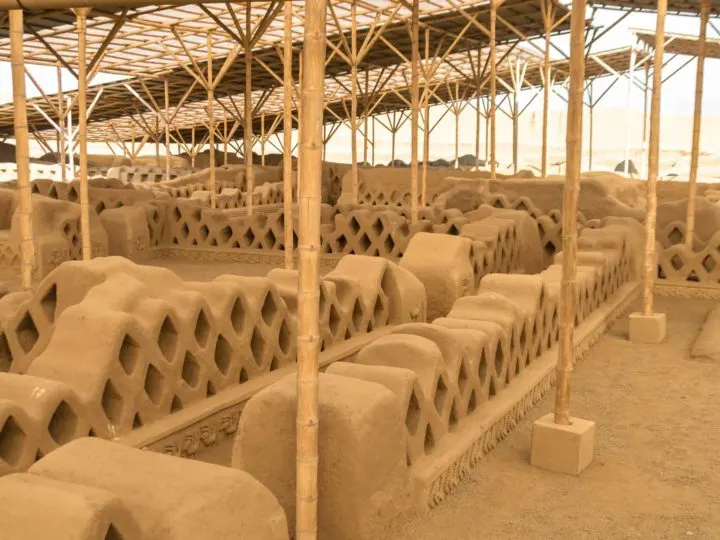
Despite over 30 years of preservation and restoration effort, only Tschudi, one of nine citadels, is open to the public.
The rest are surrounded in scaffolding and tarps, as the local archaeologists continuing trying to protect what still stands from their greatest enemy: the weather.
It really is an incredible site: meter-tall mud walls rising out of the arid desert floor with a labyrinth of inner corridors decorated with ornate images of animals and geometric designs carved into the adobe.
You definitely get a sense of the grandeur that this city once had, and it is interesting to see a place so entirely different to others in Peru.
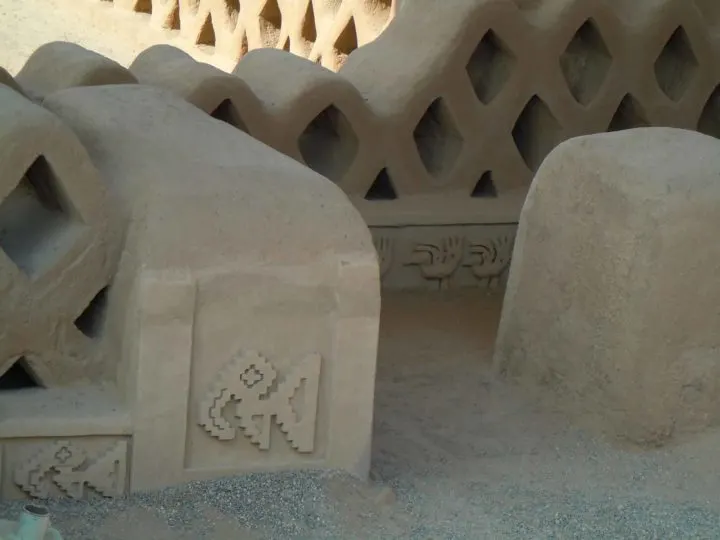
With climate change and funding cuts looming, there is a worry that this beautiful site won’t receive the protection it needs. Being built from just mud and sand, Chan Chan is incredibly vulnerable.
It is the time to go enjoy the fading majesty of the Chimu people before it crumbles to dust.
How to get to Chan Chan from Huanchaco or Trujillo
Wave down any of the collectivos on the beach main road that are heading towards Trujillo. Tell the driver you want to go to “La entrada para Chan Chan” and pay the S./ 1 ticket.
The drive should take about 10 minutes before you see the large flat expanse of Chan Chan’s many citadels.
From Trujillo, take any collectivo heading in the direction of Huanchaco and ask the driver to tell you where to get off.
You can either head straight to the main entrance or go in through the museum. The museum is small and doesn’t contain a lot and if you want to dive deeper into the history of the Chimu culture, the Museo Larco Museum in Lima is a better option.
It has hundreds of examples of Chimu artefacts, many found in Chan Chan, as well as pre-Columbian art from many other regions.
The site is open between 9am and 4pm, but is closed on Wednesdays so be sure to time your visit accordingly. Early morning is recommending because the scorching sun becomes baking in the midday heat and there’s no shade to be found.
How much does it cost to visit Chan Chan?
The ticket costs S./10 ($3), granting access to the main site, the museum and two other lesser visited and maintained citadels located close by. There are local guides available at the front gate for a fee, but be aware that there is no standard pricing for this service.
Huaca del Sol and Huaca de La Luna
South of Trujillo stand two pyramids, constructed by the Moche, a civilization that reigned along the Peruvian coast from 100 to 800 AD.
Centuries older than Chan Chan, these huacas or temples formed the Moche capital city called Cerro Blanco – named for a nearby volcano.
Part of the site’s interest is the fact that it was so remarkably preserved through the ages.
The Huaca de La Luna was entirely buried in sand up until excavations began around 20 years ago, while Huaca del Sol, lying 500 metres away in the desert, remains mostly buried.
Despite parts of Huaca del Sol being destroyed by looters and weather, it is still the biggest pre-Columbian structure in Peru and the careful restoration of this site gives fascinating insight into an ancient culture.
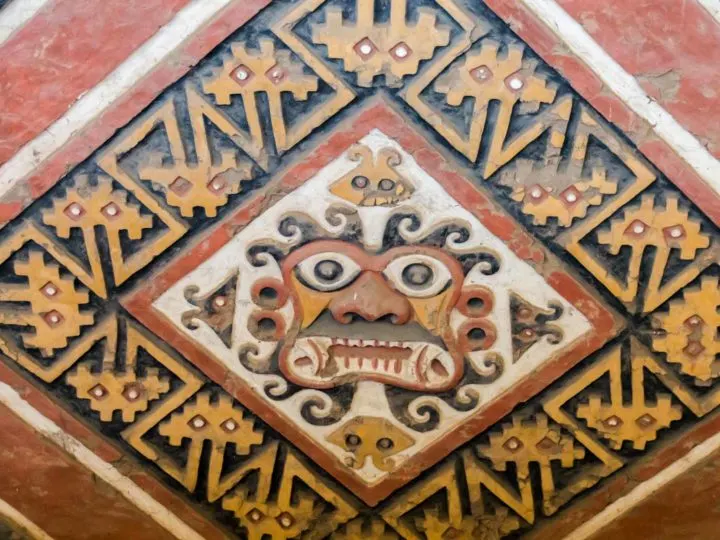
Due to it being protected underneath the cover of sand through the centuries, the designs painted onto the walls and the carefully crafted mosaics have preserved their designs and colour. The decorations celebrated and depicted Moche deities.
A visit to the site comes with a compulsory guide so be aware that you won’t be able to wander around the patterned walls alone. However, you will be able to hear fantastic stories about the Moche with their human sacrifices, epic warrior tales and odd building practices.
How to get to Huaca de La Luna y del Sol
Catch a collectivo to Trujillo from the main road along the beach and ask to be dropped of at Plaza de Armas. From there walk down Huayna Cuapac street for about a kilometer until you reach Avenida Los Incas.
Frequent collectivos on the way to Huacas pass on this busy road but be sure to say where you are going (Los Huacas) to be sure you have the right one. After a 20 minute drive, you’ll be let out at the front entrance.
The bus to Trujillo should cost S./ 1.50 and the bus to Huaca del Luna should be S./ 3.00.
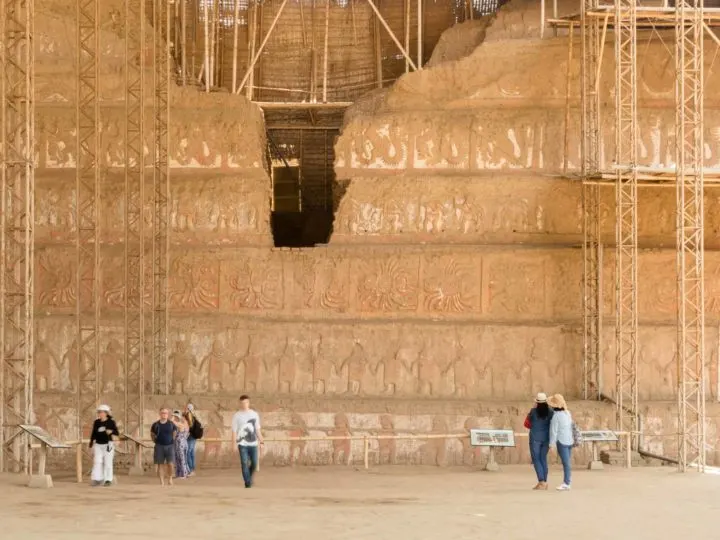
When you want to head home, wait outside the entrance and a passing collectivo will take you back to Trujillo. Ask for ‘Huayna Cuapac calle’ to get back to Plaza de Armas.
The site opens at 9am and closes at 4pm, seven days a week.
How much does it cost to visit Huaca de La Luna y del Sol?
The entrance fee is S./10 ($3) and because this site received no government funding, your support would be appreciated. The fee comes with a tour guide and you are only allowed to enter the site with them at your side. Tips are not obligatory but highly recommended.
The on-site Museo Huacas de Moche is also a great spot for appreciating many of the spectacular ceramics and other artefacts excavated from the site. The entrance is a further S./ 5.
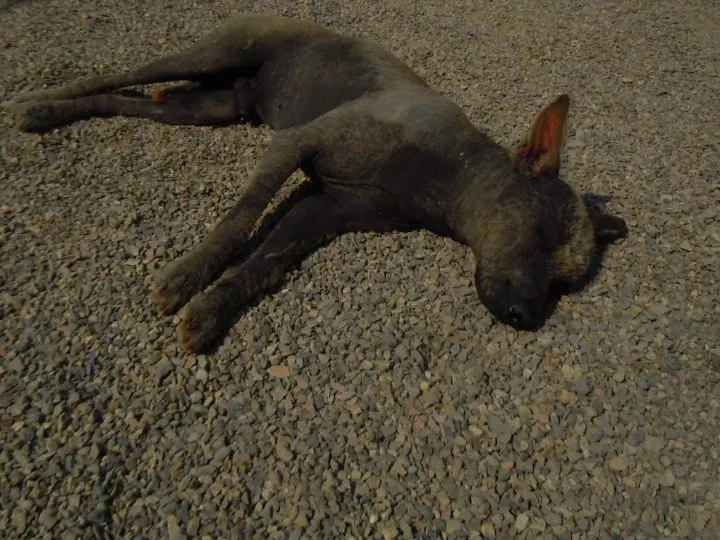
Colonial Trujillo
Trujillo was first city in Peru to be given independence from Spain and since then, it has been celebrated for its role in the fight for Peru’s independence.
Steeped in history, the Plaza de Armas of Peru’s third most populated city is bordered with colourful colonial buildings that celebrates both the past and present.
There are also plenty of things to do here in Trujillo, making it a good stop for an afternoon or evening meal.
For best views of the yellow-painted cathedral that dominates the Plaza de Armas, stay at the affordable but historic Costa del Sol (S/300 ($90 USD) double) and make sure you sample the city’s finest dining on a restored, 18th century wooden balcony at El Celler de Cler.
The Museo de Arqueología y Antropología
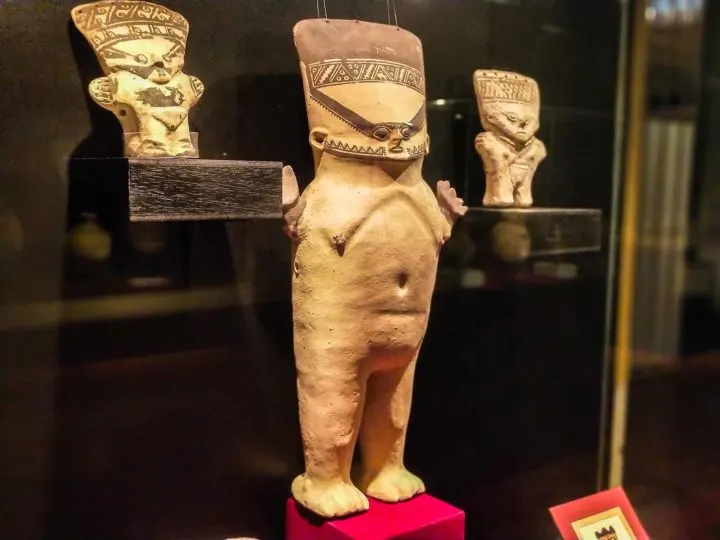
Given the array of ancient sites located in the vicinity of Trujillo, it should come as no surprise that the city has its own archaeology and anthropology museum.
Although it certainly doesn’t compete with the bling of the Museo de las Tumbas Reales in Lambeyeque further north, or the Museo Larco in Lima, it still makes for a fascinating and insightful introduction to some of the country’s lesser-known civilisations that inhabited the north.
The Museo del Jugete
Another interesting stop in Trujillo is the interesting toy museum, which comprises a collection around 5,000 pieces strong. They all belong to local artist Gerardo Chávez and the most fascinating are the ancient (circa 100 AD) toys on display.
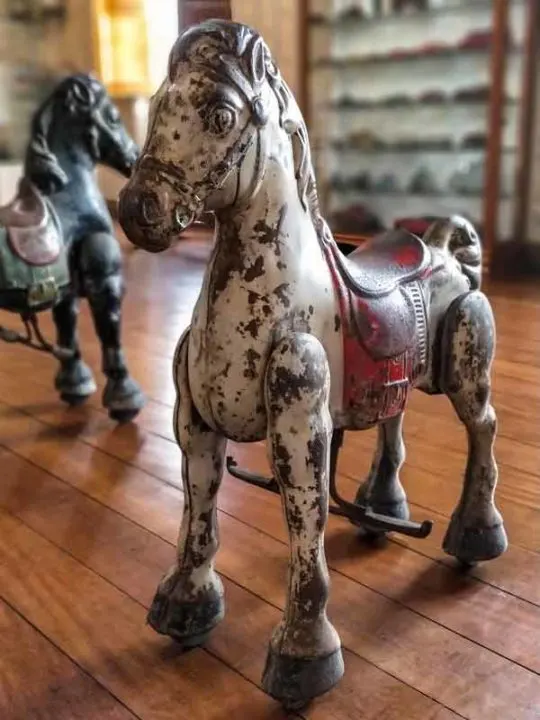
Downstairs, the Museo Café Bar – also owned by Chávez – is a relaxed destination for coffee, dinner or drinks to a backdrop of jazz.
How to get to Huanchaco
So you are excited about Huanchaco, but how do you get there? You have two choices, by flight or bus.
Of course the bus will be far cheaper (between $7 and $27 dollars depending on the distance), but they are overnight trips.
Lima to Trujillo by bus takes around eight hours and you’ll then need to take a local bus or a taxi to Huanchaco. All long distance buses go to Trujillo, and there are none directly to Huanchaco.
Trujillo sits on the Pan-American Highway so you can get busses from almost anywhere in Central or Northern Peru.
Flights to the Trujillo airport are domestic only, with daily flights to and from Lima which usually cost around $80 and take about 1 hour 20 minutes (Check out our review of Selina for your guide to where to stay in Lima).
The airport is between the Trujillo and Huanchaco, so to get out you must either take a taxi (the fares are posted on a board outside the airport but it should be around S./20 or $6) or walk out onto the road and catch a collectivo going to Huanchaco.
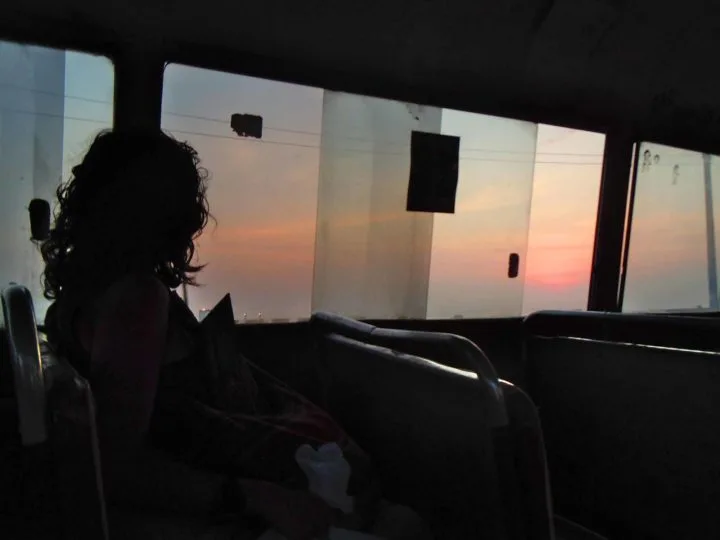
There are four bus routes from Trujillo to Huanchaco which take about 20 minutes. The big red and yellow local busses should have a Huanchaco sign on the front and cost S./1.50.
The routes are called A, B, C and H but be sure to get them going in the right direction. Safer to just look for the Huanchaco signs in the front window or to ask the driver.
Where to stay in Huanchaco
Many budget backpackers sit along Los Pinos street where between S./ 20 – 30 ($6 – $10) will get you a room and some breakfast. T
here is a bit of turnover in these parts – and many are still recovering from the floods that hit the area in March 2017 – so look up which ones seem to be doing well at the time or just have a wander around and find one that looks good.
I stayed at Moksha Surf and Yoga Hostel (formerly Meri Surf Hostel) for a week and I could have stayed far longer. Situated on the beach facing road, this quiet hostel offers quiet chill spaces, a surf school, lovely staff and amazing vegetarian food. The rooms rates are fairly standard at S./ 25 ($7.50) for dorms and private rooms starting at S./ 50 ($ 15 USD).
Another alternative – particularly if you love your yoga – is the cosy, clean and relaxed ATMA (S./25 dorm ($7.50 USD), S./ 75 ($22.5 USD) double). It’s on the northern side of town and still very close to the sea, with large dorms, communal spaces and a kitchen.
If you are not looking for a hostel, try Hospedaje Fremiott (S./67 ($20 USD) single or double). It is very close to the beach and run by a friendly family. Do be warned that they speak very little English but it is a great way to practise any budding Spanish.
Pin to your favourite Pinterest board to save this article for later!
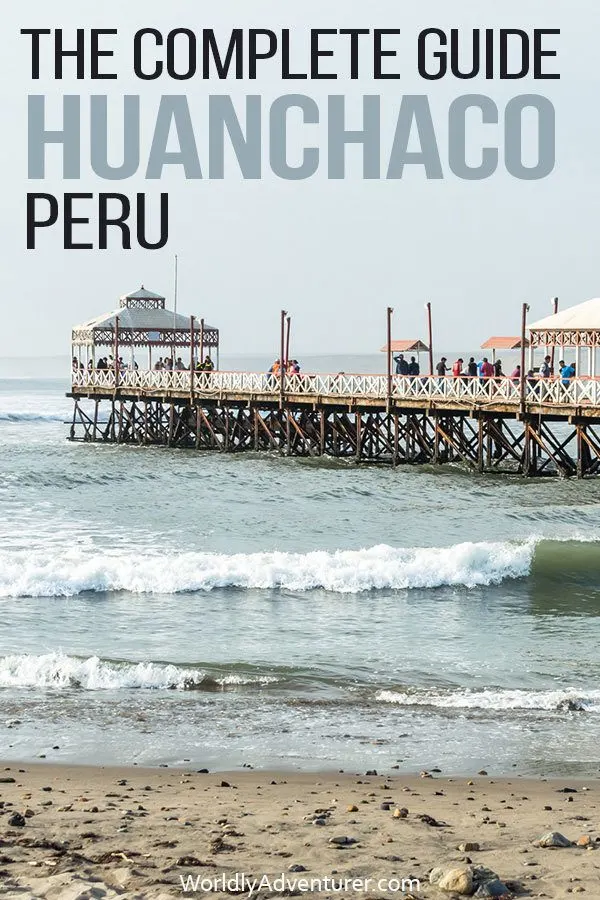

Roxana Gonzales
Wednesday 19th of July 2023
Thank you so much I’m a Peruvian native and I didn’t know that much about huanchaco great information Roxana